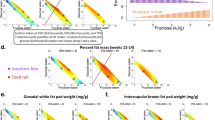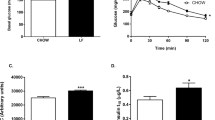Abstract
Objectives:
In diet-induced obesity, it is not clear whether impaired glucose metabolism is caused directly by the diet, or indirectly via obesity. This study examined the effects of different free-choice, high-caloric, obesity-inducing diets on glucose metabolism. In these free-choice diets, saturated fat and/or a 30% sugar solution are provided in an addition to normal chow pellets.
Method:
In the first experiment, male rats received a free-choice high-fat high-sugar (HFHS), free-choice high-fat (HF) or a chow diet. In a second experiment, male rats received a free-choice high-sugar (HS) diet or chow diet. For both experiments, after weeks 1 and 4, an intravenous glucose tolerance test was performed.
Results:
Both the HFHS and HF diets resulted in obesity with comparable plasma concentrations of free fatty acids. Interestingly, the HF diet did not affect glucose metabolism, whereas the HFHS diet resulted in hyperglycemia, hyperinsulinemia and in glucose intolerance because of a diminished insulin response. Moreover, adiposity in rats on the HF diet correlated positively with the insulin response to the glucose load, whereas adiposity in rats on the HFHS diet showed a negative correlation. In addition, total caloric intake did not explain differences in glucose tolerance. To test whether sugar itself was crucial, we next performed a similar experiment in rats on the HS diet. Rats consumed three times as much sugar when compared with rats on the HFHS diet, which resulted in obesity with basal hyperinsulinemia. Glucose tolerance, however, was not affected.
Conclusion:
Together, these results suggest that not only obesity or total caloric intake, but the diet content also is crucial for the glucose intolerance that we observed in rats on the HFHS diet.
This is a preview of subscription content, access via your institution
Access options
Subscribe to this journal
Receive 12 print issues and online access
$259.00 per year
only $21.58 per issue
Buy this article
- Purchase on Springer Link
- Instant access to full article PDF
Prices may be subject to local taxes which are calculated during checkout






Similar content being viewed by others
References
Batsis JA, Nieto-Martinez RE, Lopez-Jimenez F . Metabolic syndrome: from global epidemiology to individualized medicine. Clin Pharmacol Ther 2007; 82: 509–524.
Brownell KD, Farley T, Willett WC, Popkin BM, Chaloupka FJ, Thompson JW et al. The public health and economic benefits of taxing sugar-sweetened beverages. N Engl J Med 2009; 361: 1599–1605.
Macdiarmid J, Loe J, Craig LC, Masson LF, Holmes B, McNeill G . Meal and snacking patterns of school-aged children in Scotland. Eur J Clin Nutr 2009; 63: 1297–1304.
Buettner R, Scholmerich J, Bollheimer LC . High-fat diets: modeling the metabolic disorders of human obesity in rodents. Obesity (Silver Spring) 2007; 15: 798–808.
Pagliassotti MJ, Prach PA, Koppenhafer TA, Pan DA . Changes in insulin action, triglycerides, and lipid composition during sucrose feeding in rats. Am J Physiol 1996; 271: R1319–R1326.
Pagliassotti MJ, Prach PA . Quantity of sucrose alters the tissue pattern and time course of insulin resistance in young rats. Am J Physiol 1995; 269: R641–R646.
Ahren B, Pacini G . Insufficient islet compensation to insulin resistance vs reduced glucose effectiveness in glucose-intolerant mice. Am J Physiol Endocrinol Metab 2002; 283: E738–E744.
Kaiyala KJ, Prigeon RL, Kahn SE, Woods SC, Porte Jr D, Schwartz MW . Reduced beta-cell function contributes to impaired glucose tolerance in dogs made obese by high-fat feeding. Am J Physiol 1999; 277: E659–E667.
Boden G . Pathogenesis of type 2 diabetes. Insulin resistance. Endocrinol Metab Clin North Am 2001; 30: 801–815 v.
Reaven GM . Banting lecture 1988. Role of insulin resistance in human disease. Diabetes 1988; 37: 1595–1607.
Lewis GF, Carpentier A, Adeli K, Giacca A . Disordered fat storage and mobilization in the pathogenesis of insulin resistance and type 2 diabetes. Endocr Rev 2002; 23: 201–229.
Cruciani-Guglielmacci C, Vincent-Lamon M, Rouch C, Orosco M, Ktorza A, Magnan C . Early changes in insulin secretion and action induced by high-fat diet are related to a decreased sympathetic tone. Am J Physiol Endocrinol Metab 2005; 288: E148–E154.
Levin BE . Reduced norepinephrine turnover in organs and brains of obesity-prone rats. Am J Physiol 1995; 268: R389–R394.
La Fleur SE, Vanderschuren LJMJ, Luijendijk MCM, Kloeze BM, Tiesjema B, Adan RA . A reciprocal interaction between food-motivated behavior and diet-induced obesity. Int J Obes (Lond) 2007; 31: 1286–1294.
La Fleur SE, van Rozen AJ, Luijendijk MC, Groeneweg F, Adan RA . A free-choice high-fat high-sugar diet induces changes in arcuate neuropeptide expression that support hyperphagia. Int J Obes (Lond) 2010; 34: 537–546.
Obici S, Feng Z, Tan J, Liu L, Karkanias G, Rossetti L . Central melanocortin receptors regulate insulin action. J Clin Invest 2001; 108: 1079–1085.
Van den Hoek AM, Voshol PJ, Karnekamp BN, Buijs RM, Romijn JA, Havekes LM et al. Intracerebroventricular neuropeptide Y infusion precludes inhibition of glucose and VLDL production by insulin. Diabetes 2004; 53: 2529–2534.
Steffens AB . A method of frequent sampling blood and continuous infusion of fluids in the rat without disturbing the animal. Physiol Behav 1969; 4: 836.
Lichtenstein AH, Schwab US . Relationship of dietary fat to glucose metabolism. Atherosclerosis 2000; 150: 227–243.
Storlien LH, Jenkins AB, Chisholm DJ, Pascoe WS, Khouri S, Kraegen EW . Influence of dietary fat composition on development of insulin resistance in rats. Relationship to muscle triglyceride and omega-3 fatty acids in muscle phospholipid. Diabetes 1991; 40: 280–289.
Wright DW, Hansen RI, Mondon CE, Reaven GM . Sucrose-induced insulin resistance in the rat: modulation by exercise and diet. Am J Clin Nutr 1983; 38: 879–883.
Paulsen SJ, Jelsing J, Madsen AN, Hansen G, Lykkegaard K, Larsen LK et al. Characterization of beta-cell mass and insulin resistance in diet-induced obese and diet-resistant rats. Obesity (Silver Spring) 2009; 18: 266–273.
Bergman RN . Minimal model: perspective from 2005. Horm Res 2005; 64 (Suppl 3): 8–15.
Bogardus C, Tataranni PA . Reduced early insulin secretion in the etiology of type 2 diabetes mellitus in Pima Indians. Diabetes 2002; 51 (Suppl 1): S262–S264.
Buijs RM, Chun SJ, Niijima A, Romijn HJ, Nagai K . Parasympathetic and sympathetic control of the pancreas: a role for the suprachiasmatic nucleus and other hypothalamic centers that are involved in the regulation of food intake. J Comp Neurol 2001; 431: 405–423.
Kalsbeek A, la Fleur S, van Heijningen C, Buijs RM . Suprachiasmatic GABAergic inputs to the paraventricular nucleus control plasma glucose concentrations in the rat via sympathetic innervation of the liver. J Neurosci 2004; 24: 7604–7613.
Moore MC, Cherrington AD . Regulation of net hepatic glucose uptake: interaction of neural and pancreatic mechanisms. Reprod Nutr Dev 1996; 36: 399–406.
Van den Hoek AM, van Heijningen C, Schro-van der Elst JP, Ouwens DM, Havekes LM, Romijn JA et al. Intracerebroventricular administration of neuropeptide Y induces hepatic insulin resistance via sympathetic innervation. Diabetes 2008; 57: 2304–2310.
Poitout V, Robertson RP . Glucolipotoxicity: fuel excess and {beta}-cell dysfunction. Endocr Rev 2008; 29: 351–366.
Hagman DK, Latour MG, Chakrabarti SK, Fontes G, Amyot J, Tremblay C et al. Cyclical and alternating infusions of glucose and intralipid in rats inhibit insulin gene expression and Pdx-1 binding in islets. Diabetes 2008; 57: 424–431.
Ferrannini E, Natali A, Bell P, Cavallo-Perin P, Lalic N, Mingrone G . Insulin resistance and hypersecretion in obesity. European Group for the Study of Insulin Resistance (EGIR). J Clin Invest 1997; 100: 1166–1173.
Ferrannini E, Balkau B . Insulin: in search of a syndrome. Diabet Med 2002; 19: 724–729.
Reaven GM, Moore J, Greenfield M . Quantification of insulin secretion and in vivo insulin action in nonobese and moderately obese individuals with normal glucose tolerance. Diabetes 1983; 32: 600–604.
Toida S, Takahashi M, Shimizu H, Sato N, Shimomura Y, Kobayashi I . Effect of high sucrose feeding on fat accumulation in the male Wistar rat. Obes Res 1996; 4: 561–568.
Ferrer-Martinez A, Marotta M, Turini M, Mace K, Gomez-Foix AM . Effect of sucrose and saturated-fat diets on mRNA levels of genes limiting muscle fatty acid and glucose supply in rats. Lipids 2006; 41: 55–62.
Havel PJ . Dietary fructose: implications for dysregulation of energy homeostasis and lipid/carbohydrate metabolism. Nutr Rev 2005; 63: 133–157.
Hallfrisch J, Lazar F, Jorgensen C, Reiser S . Insulin and glucose responses in rats fed sucrose or starch. Am J Clin Nutr 1979; 32: 787–793.
White BD, He B, Dean RG, Martin RJ . Low protein diets increase neuropeptide Y gene expression in the basomedial hypothalamus of rats. J Nutr 1994; 124: 1152–1160.
White BD, Dean RG, Martin RJ . An association between low levels of dietary protein, elevated NPY gene expression in the basomedial hypothalamus and increased food intake. Nutr Neurosci 1998; 1: 173–182.
Du F, Higginbotham DA, White BD . Food intake, energy balance and serum leptin concentrations in rats fed low-protein diets. J Nutr 2000; 130: 514–521.
Goettsch M . Minimum protein requirement of the adult rat for 28-day periods of maintenance of body weight. J Nutr 1951; 45: 609–620.
Acknowledgements
We thank Dr JM Chou-Green for English editing and Drs MJM Serlie and M Soeters for critically reading the manuscript. This research was supported by the Netherlands Organization for Scientific Research (ZonMw 916.56.020).
Author information
Authors and Affiliations
Corresponding author
Ethics declarations
Competing interests
The authors declare no conflict of interest.
Additional information
Supplementary Information accompanies the paper on International Journal of Obesity website
Supplementary information
Rights and permissions
About this article
Cite this article
la Fleur, S., Luijendijk, M., van Rozen, A. et al. A free-choice high-fat high-sugar diet induces glucose intolerance and insulin unresponsiveness to a glucose load not explained by obesity. Int J Obes 35, 595–604 (2011). https://doi.org/10.1038/ijo.2010.164
Received:
Revised:
Accepted:
Published:
Issue Date:
DOI: https://doi.org/10.1038/ijo.2010.164
Keywords
This article is cited by
-
Interaction between CETP polymorphism and dietary insulin index and load in relation to cardiovascular risk factors in diabetic adults
Scientific Reports (2021)
-
Differential response of rat strains to obesogenic diets underlines the importance of genetic makeup of an individual towards obesity
Scientific Reports (2017)
-
Combination of a high-fat diet with sweetened condensed milk exacerbates inflammation and insulin resistance induced by each separately in mice
Scientific Reports (2017)
-
Enhanced sensitivity to drugs of abuse and palatable foods following maternal overnutrition
Translational Psychiatry (2016)
-
The snacking rat as model of human obesity: effects of a free-choice high-fat high-sugar diet on meal patterns
International Journal of Obesity (2014)



